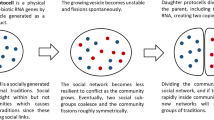Abstract
Evolution and life phenomena can be understood as results of history, i.e., as outcomes of cohabitation and collective memory of populations of autonomous entities (individuals) across many generations and vast extent of time. Hence, evolution of distinct lineages of life can be considered as isomorphic with that of cultures. I argue here that cultures and culture-like systems – human culture, natural languages, and life forms – always draw from history, memory, experience, internal dynamics, etc., transforming themselves creatively into new patterns, never foreseen before. This is possible thanks to the fact that all forms of life are descendants of life. Ontogeny and speciation in various lineages draw from continuous re-interpretation of conservative genetic/generic “texts”, as well as from changes of the interpretative process itself. The result is continuous appearances of new lineages-cultures and/or communities-cultures, in a semiotic process of re-interpretation and inventing new ways of living. The topic is developed here on the backgrounds of ideas presented by R. A. Rappaport in “Ritual and religion in the making of humanity” and J. Flegr in “Frozen evolution”.
Similar content being viewed by others
Notes
As to differences between complex systems (i) born and (ii) emerging de novo, see Markoš and Das (2016).
References
Allis, C. D., Jenuwein, T., & Reinberg, D. (2007). Epigenetics. Cold Spring Harbor: Cold Spring Harbor Laboratory Press.
Bachelard, G. (1971). The poetics of reverie. Childhood, language, and the cosmos. Boston: Beacon Press.
Barbieri, M. (2003). The organic codes. An introduction to semantic biology. Cambridge: Cambridge University Press.
Barbieri, M. (2008). Biosemiotics: a new understanding of life. Naturwissenschaften, 95, 577–599.
Barbieri, M. (2011). A mechanistic model of meaning. Biosemiotics, 4, 1–4.
Eco, U. (1976). A theory of semiotics. Bloomington: Indiana University Press.
Eco, U. (1995). The search for the perfect language. London: Fontana Press.
Flegr, J. (2008). Frozen evolution, or, that’s not the way it is, Mr Darwin. Prague: Charles University.
Gilbert, S. F., & Epel, D. (2008). Ecological developmental biology. Sunderland: Sinauer Associates.
Hallgrímsson, B., & Hall, B. K. (Eds.). (2011). Epigenetics. Linking genotype and phenotype in development and evolution. Oakland: University of California Press.
Harris, R. (2001). Rethinking writing. The tyranny of alphabet and how to escape from it. London: Continuum.
Harris, R. (2009). Rationality and the literate mind. New York: Routlege.
Heidegger, M. (1995 [1982]). The fundamental concepts of metaphysics. World, finitude, solitude. Bloomington: Indiana University Press.
Hesse, H. (1990 [1943]). The glass bead game (Magister ludi). New York: Henry Holt & Co.
Kauffman, S. A. (2000). Investigations. New York: Oxford University Press.
Komárek, S. (2009). Nature and culture. The world of phenomena and the world of interpretation. München: LINCOM publishers.
Kull, K., Deacon, T., Emmeche, C., Hoffmeyer, J., & Stjernfelt, F. (2009). Theses on biosemiotics: prolegomena to a theoretical biology. Biological Theory, 4, 167–173.
Lewin, K. (1922). Der Begriff der Genese in Physik, Biologie und Entwicklungsgeschichte. Berlin: Julius Springler.
Lorenz, K. (1966). On agression. London: Methuen.
Lotman YM (2009 [1992]) Culture and explosion. Berlin: Mouton de Gruyter 2009.
Markoš, A. (2002). Readers of the book of life. Oxford: Oxford University Press.
Markoš, A. (2010). Biosemiotics and the collision of modernism with the postmodernity. Cognitio (Sao Paulo), 11, 69–78.
Markoš, A. (2014). Biosphere as semiosphere: variations on Lotman. Sign Systems Studies, 42, 487–498.
Markoš, A., & Faltýnek, D. (2011). Language metaphors of life. Biosemiotics, 4, 171–200.
Markoš, A., & Faltýnek, D. (2015). Language and biosphere: Blurry contours as a condition of semiosis. In E. Velmezova, S. Cowley, & K. Kull (Eds.), Biosemiotic perspectives on language and Linguistics (pp. 29–45). Berlin: Springer.
Markoš, A., & Švorcová, J. (2009). Recorded versus organic memory. Biosemiotics, 2, 131–149.
Markoš, A., Grygar, F., Hajnal, L., Kleisner, K., Kratochvíl, Z., & Neubauer, Z. (2009). Life as its own designer: Darwin’s origin and western thought. Berlin: Springer.
Pátková, I., Čepl, J. J., Blahůšková, A., Neubauer, Z., & Markoš, A. (2012). Developmental plasticity of bacterial colonies and consortia in germ-free and gnotobiotic settings. BMC Microbiology, 12, 171.
Rappaport, R. A. (2010 [1999]). Ritual and religion in the making of humanity. Cambridge: Cambridge University Press.
Schmalhausen, I. I. (1986 [1946]). Factors of evolution. The theory of stabilizing selection. Chicago: University of Chicago Press.
Sebeok, T. A. (1994). Signs: An introduction to semiotics. Toronto: University of Toronto Press.
Taipale, M., Jarosz, D. F., & Lindquist, S. (2010). HSP90 at the hub of protein homeostasis: emerging mechanistic insights. Nature Reviews Molecular Cell Biology, 11, 515–28.
Acknowledgments
Supported by the Czech Science Foundation 13-24275S.
Author information
Authors and Affiliations
Corresponding author
Rights and permissions
About this article
Cite this article
Markoš, A. The Birth and Life of Species–Cultures. Biosemiotics 9, 73–84 (2016). https://doi.org/10.1007/s12304-015-9252-1
Received:
Accepted:
Published:
Issue Date:
DOI: https://doi.org/10.1007/s12304-015-9252-1




